History of Naryan-Mar
Early history of Naryan-Mar
The idea of building a city in the lower reaches of the Pechora River appeared quite a long time ago. Large reserves of wood and an abundance of wildlife along with a large navigable river attracted people to the North. According to Russian chronicles, the area of Lower Pechora was well known from the 12th century. Here the local tribes (the Yugra and the Pechora) carried out an exchange trade with the Russians.
In 1499, Pustozersk was founded about 20 km from the present city of Naryan-Mar. It became the first Russian town beyond the Arctic Circle and one of the main outposts of Russia in the development of the North and Siberia. Since the 18th century, it gradually began to lose its significance. It was finally abandoned in 1962. Today, it is a historical and cultural monument.
In the 18th-19th centuries, new villages appeared on the banks of the Pechora estuary. Their residents were engaged in traditional farming, fishing, hunting, and reindeer husbandry. In 1897, the Partnership of the Arkhangelsk-Murmansk Shipping Company established sea voyages between Arkhangelsk and the lower reaches of the Pechora (the village of Kuya).
In 1902, on the territory of today’s Naryan-Mar, the construction of a steam sawmill of the Partnership “Stella Polare” began. It was one of the largest enterprises in the Arkhangelsk Governorate. The time of its heyday was in 1907-1914. In November, 1918, the sawmill burned down. It was rebuilt a few years after the end of the Russian Civil War.
More Historical Facts…
Foundation of Naryan-Mar
The predecessor of Naryan-Mar - the settlement of Beloshchelsky (Beloschelye) with a population of 29 people is mentioned in the list of settlements of the Arkhangelsk Governorate as of May 1, 1922. In 1924, the first building of the future city of Naryan-Mar was constructed in Beloschelye - the agency of “Northern Shipping Company”. The decision to build a new city and port on the Pechora River was made at the meeting held on board the steamer “Umba” at the Beloschelye pier on October 7, 1929.
The main reason for the construction of the port was the discovery of the Vorkuta coal deposit. There was only one way to deliver coal to the consumers, as well as cargo for the construction of the Vorkuta mines - through the Pechora port. Thus, the village of workers named Naryan-Mard was formed uniting the territories and population of several local villages. The name “Naryan-Mard” was assigned to the newly formed village on October 10, 1931.
The first buildings were a dwelling barrack for 65 people, an eight-apartment building, a canteen, a post office, “The House of the Nenets”, a hospital, and a printing house. On December 18, 1931, the name of the village changed slightly and became more euphonic - Naryan-Mar. On March 2, 1932, the administrative center of the Nenets National District was moved to Naryan-Mar.
On February 13, 1933, the first polar airline was opened, which connected Arkhangelsk with Naryan-Mar. On March 10, 1935, Naryan-Mar, which already had over 8,000 residents, was transformed into a city. By 1939, the population of Naryan-Mar grew to 13.7 thousand people. Until 1940, about 120 wooden residential buildings were built.
Thus, in just a few years of rapid construction, the city of Naryan-Mar grew up on the banks of the Pechora - a polar city of fishermen, reindeer herders, and workers; sea, river and air gates to the Arctic; the most important administrative, cultural, and commercial center of the Nenets National District.
During the Second World War, Naryan-Mar was a rear city. In October 1941, a military airfield began operating in it. Aircraft from Naryan-Mar performed reconnaissance flights in the Arctic. On June 22, 1943, a German U-88 aircraft flew over Naryan-Mar for the first time in the entire war, it carried out aerial photography of the city and nearby settlements.
Naryan-Mar in the second half of the 20th century and beyond
In 1955, the first bus route opened. An important milestone in the history of Naryan-Mar was the commissioning of a thermal power plant with a capacity of 500 kW (1956), which made it possible to reliably electrify Naryan-Mar.
Large-scale construction began in Naryan-Mar from the mid-1970s, the seaport was reconstructed. In 1975, the construction of the first multi-storey brick building was completed - the building of the city administration. In 1977, a gas pipeline was built from the Vasilkovskoye gas condensate field and gasification of the city began. In 1981, the first five-story panel 60-apartment residential building was commissioned. In 1989, the population of Naryan-Mar was about 20 thousand people.
In the 1990s, the pace of development of the city, like that of the entire country, decreased, some residents began to leave Naryan-Mar. However, during these years, several large construction projects of social significance were completed - the airport building (1992), the main building of the district hospital (1994), the hotel “Pechora”, the sports club “Nord” (1995), the district school #5 (2000), the cultural and sports complex (2000), etc.
Due to an acute shortage of raw materials, the oldest enterprises in the region, the Pechora Sawmill and the Fish Processing Plant were liquidated in 2002-2004.
Since the beginning of the 21st century, with the growth of oil production in the Nenets Autonomous Okrug, the city has received a new impetus in its development. Over the first decade, dozens of modern monolithic and brick buildings were constructed, roads and communications were built and repaired, dilapidated housing was being actively demolished.
On November 3, 2013, the Olympic torch relay stage of the 2014 Winter Olympics took place in Naryan-Mar.
Naryan-Mar views
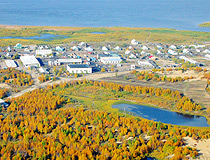
Naryan-Mar from above
Author: Malkova Galina
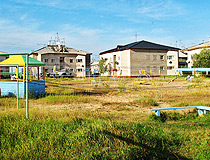
Residential buildings in Naryan-Mar
Author: Vladimir Gubatov
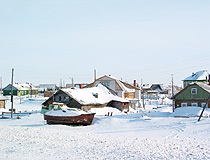
Winter in Naryan-Mar
Author: Igor Gots
Naryan-Mar - Features
Naryan-Mar is located a little north of the Arctic Circle, at approximately the same latitude as the city of Vorkuta. The distance from Moscow to Naryan-Mar is about 1,500 km. The City Day of Naryan-Mar is celebrated on the first Sunday in September.
The city’s coat of arms depicts a reindeer head symbolizing the main occupation of the indigenous population of the Nenets Autonomous Okrug - reindeer husbandry. Also on it you can see two fish symbolizing fishing. The blue stripe in the form of waves emphasizes that Naryan-Mar is a sea and river port. The red color symbolizes the translation of the name Naryan-Mar from the Nenets language - “Red City”.
Naryan-Mar is not connected with other Russian cities by either a permanent road or a railroad. Usinsk, the nearest railway station, is located at a distance of 420 km. It is possible to reach it by land only from December to April along a winter road (“zimnik”). At present, the construction of the Naryan-Mar-Usinsk highway is underway, which should be completed in the mid-2020s.
The airport of Naryan-Mar offers regular flights to Moscow, St. Petersburg, Arkhangelsk, Ufa, Yekaterinburg, Chelyabinsk, Krasnodar. Cargoes are delivered to the city by sea from Arkhangelsk, as well as by river from the city of Pechora.
The climate of Naryan-Mar is subarctic, with long winters and short, cool summers. Winters are relatively mild for the polar latitudes due to the influence of the Barents Sea. However, springs and autumns are long and cold, while summers are relatively warm and short.
The polar day lasts from May 29 to July 15 and white nights are observed from April to August. The polar night lasts from December 14 to 29. The average temperature in January is minus 17.2 degrees Celsius, in July - plus 13.5 degrees Celsius.
The local economy is based on the fuel industry: oil and natural gas production, oil refining. Geological exploration of tundra and shelf deposits is also of great importance for the economy of Naryan-Mar.
Main Attractions of Naryan-Mar
Pedestrian Smidovicha Street - the historic and cultural center of Naryan-Mar. Here you can find the buildings of the city administration, post office, administration of the Nenets Autonomous Okrug, the Palace of Justice, the Palace of Culture “Arctic”. It is one of the oldest streets in the city with a lot of two-story wooden buildings built between the 1930s and 1950s.
Today, Smidovicha Street is paved with cobblestones; earlier city residents walked along wooden sidewalks. The street is named after Petr Germogenovich Smidovich (1874-1935), who, in the 1920s-1930s, headed the Committee of the North and took an active part in the creation of the Nenets Autonomous Okrug.
The Post Office of Naryan-Mar (1946-1952) - a wooden architectural monument of local importance and one of the symbols of Naryan-Mar. The uniqueness of the building is given by its corner, which consists of five volumes of various shapes. Smidovicha Street, 25.
Ethnocultural Center of the Nenets Autonomous Okrug. It is located in the Palace of Culture “Arctic” in the very center of Naryan-Mar. The main task of the center is to preserve and revive the culture and traditions of the peoples living in the territory of the Nenets Autonomous Okrug. Visitors are given the opportunity to try on national costumes and take photographs, buy souvenirs made by local craftsmen. Folk art festivals are held here. Smidovicha Street, 20a.
Monument to the Yak-7B Fighter Aircraft. During the Second World War, residents of Naryan-Mar raised funds on their own and purchased a Yak-7B fighter aircraft. On September 7, 1944, it was given to one of the talented pilots of the White Sea flotilla, Tarasov Alexei Kondratyevich. In total, he made more than three hundred flights until the end of the war and shot down twelve German aircraft.
After the war, Tarasov handed over the aircraft to the residents of the city. It was installed on a high pedestal in the area of the seaport. Unfortunately, over time, this place fell into disrepair and the original aircraft was lost. Its replica was installed in the same place in 2010. The crossroads of Lenina and Smidovicha streets near Lenina Square.
Epiphany Cathedral (1996-2004) - a picturesque wooden church built of Siberian cedar, one of the tallest buildings in Naryan-Mar (35 meters). This cathedral complex is an example of the stylization of wooden architecture of the Russian North of the 17th-18th centuries. Lenina Street, 7.
Nenets Museum of Local Lore - the largest museum of the Nenets Autonomous Okrug with exhibitions on the history and ethnography, nature, paleontology and geology of this region. The exposition of nature and paleontology reveals the peculiarities of the flora and fauna of the region, its geological structure and minerals.
The most valuable collection is the collection of Nenets ethnography reflecting the material and spiritual culture of the indigenous inhabitants of the European tundra of the late 19th-20th centuries. The history exposition tells about the history of this region since ancient times. Pobedy Street, 5.
Monument to Reindeer Transport Battalions (2012). During the Second World War, the residents of the Nenets Autonomous Okrug formed five reindeer transport echelons, with a total number of more than 600 people and more than 7,000 sled reindeer. These echelons became the basis for the creation of reindeer-ski battalions and reindeer transports on the Karelian front. The monument depicts a battalion fighter with a reindeer and a dog in the disk of the polar sun. Pobedy Street, next to the Nenets Museum of Local Lore.
Museum-Reserve “Pustozersk”. Pustozersk, founded in 1499, was the first Russian settlement on the Pechora. It was located about 20 km from today’s Naryan-Mar. Throughout the 16th-18th centuries, it was a large economic and administrative center of the entire Pechora region. In 1993, the museum got its own building in Naryan-Mar, which had been transported from Pustozersk in the 1930s. Today, it has the permanent exhibition “Northern House: its appearance and soul”. Tyko Vylki Street, 4.
Center for Folk and Applied Arts - a place for exhibitions of Naryan-Mar craftsmen and amateur artists. Here you can sign up for various master classes and purchase products from Nenets craftsmen engaged in sewing, making toys, knitting, modeling, soap making, beading, etc. Tyko Vylki Street, 2a.


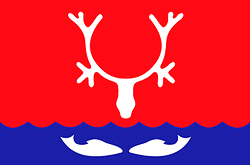
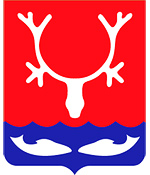



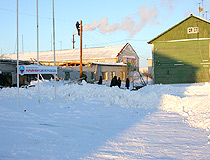
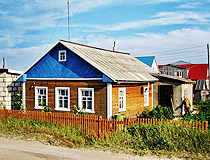
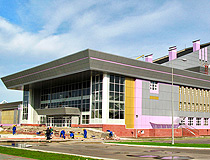
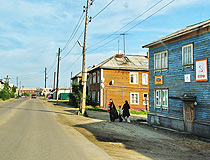
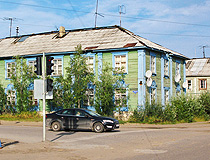
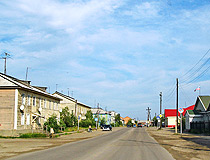

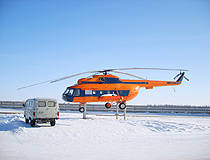
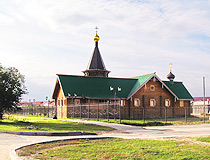
The comments of our visitors